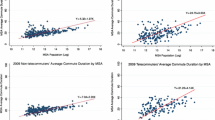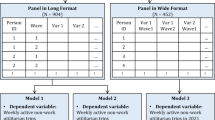Abstract
The current study contributes to the already substantial scholarly literature on telecommuting by estimating a joint model of three dimensions—option, choice and frequency of telecommuting. In doing so, we focus on workers who are not self-employed workers and who have a primary work place that is outside their homes. The unique methodological features of this study include the use of a general and flexible generalized hurdle count model to analyze the precise count of telecommuting days per month, and the formulation and estimation of a model system that embeds the count model within a larger multivariate choice framework. The unique substantive aspects of this study include the consideration of the “option to telecommute” dimension and the consideration of a host of residential neighborhood built environment variables. The 2009 NHTS data is used for the analysis, and allows us to develop a current perspective of the process driving telecommuting decisions. This data set is supplemented with a built environment data base to capture the effects of demographic, work-related, and built environment measures on the telecommuting-related dimensions. In addition to providing important insights for policy analysis, the results in this paper indicate that ignoring the “option” dimension of telecommuting can, and generally will, lead to incorrect conclusions regarding the behavioral processes governing telecommuting decisions. The empirical results have implications for transportation planning analysis as well as for the worker recruitment/retention and productivity literature.
Similar content being viewed by others
Notes
See Bhat and Guo (2007) for a description of the data sources and methodologies for computing the BE measures.
The descriptive sample statistics for the exogenous variables in our analysis are suppressed here due to space considerations. Suffice it to say that the sample statistics are close to the corresponding population statistics for the San Francisco Bay region. Interested readers may refer to the supplementary document by Singh et al. (2012) available at: http://www.caee.utexas.edu/prof/bhat/ABSTRACTS/Telecommuting/SuppNote.pdf.
The scale of each of the error terms must be set to 1 for identification resulting in a correlation matrix.
As we will discuss later, the option effect mentioned here is only valid for women who have a one-way commute of less than or equal to 20 miles, though the choice effect is for all women.
We also tested the interaction of female and the presence of children in different age categories (0–5 years, 5–10 years, and 11–15 years). However, none of these came out to be even marginally statistically significant in all three telecommuting components.
Admittedly, the occupation type categorization in the NHTS data is very coarse. It also co-mingles industry type and job type. The effects of the occupation type variables should, therefore, be viewed with some caution, and only as broad characterizations of job and industry mix.
More broadly speaking, there could be some validity to the argument that all work-related decisions (including telecommuting, work schedule flexibility, full time versus part-time) and residential location choice decisions should be modeled in one single joint model system that implicitly determines the choice of a work location and commute trip attributes. But such a framework would become unwieldy. Also, there is some suggestion in the literature (see Ellen and Hempstead 2002; Ory and Mokhtarian 2006) that individuals tend to make their work/home location choices prior to decisions on telecommuting. Further exploration of this endogeneity issue is needed to inform modeling.
A “Second City” as used in the NHTS data, refers to secondary cities surrounding a major metropolitan area. However, they are not equivalent to suburbs of the metropolitan area, which are within the major metropolitan area boundary. “Second cities” are generally satellite cities outside the major city metropolitan area. They may be viewed as somewhere between a suburb and a rural area in built-up land-use density.
The adjusted rho-bar squared value \( \bar{\rho }_{c}^{2} \) is computed as \( \bar{\rho }_{c}^{2} = 1 - [(L(\hat{\beta }) - H)/L(C)] \), where \( L(\hat{\beta }) \) is the predictive log-likelihood for the trivariate model and the convergent log-likelihood for the bivariate model, H is the number of model parameters excluding the constants in the binary models and the constant in the ς vector for the count model, and L(C) is the log-likelihood from the bivariate model with only the constant in the binary choice model and the constant in the ς vector.
The hurdle set-up for the telecommuting frequency in the bivariate case is derived in the same way as that for the trivariate case.
The elasticity effects here computed in this section provides the cumulative effect of variables on the expected number of days of telecommuting per month. While helpful in terms of the bottom line, the effects of variables on each individual dimension still provides insights for policy analysis, as already discussed in the previous section. The elasticity effects presented here are simply to illustrate the overall differences in magnitude effects between the bivariate model (that ignores the option dimension) and the trivariate model. One can further break down the elasticity effects shown here into separate components specific to each dimension of effect to gain more insights, but this is straightforward to do and we do not pursue this here to conserve on space.
References
Basar, G., Bhat, C.R.: A parameterized consideration set model for airport choice: an application to the San Francisco Bay area. Transp. Res. Part B 38(10), 889–904 (2004)
Bernardino, A., Ben-Akiva, M.: Modeling the adoption of telecommuting: comprehensive framework. Transp. Res. Rec. 1552, 161–170 (1996)
Bhat, C.R., Guo, J.Y.: A comprehensive analysis of built environment characteristics on household residential choice and auto ownership levels. Transp. Res. Part B 41(5), 506–526 (2007)
Castro, M., Paleti, R., Bhat, C.R.: A latent variable representation of count data models to accommodate spatial and temporal dependence: application to predicting crash frequency at intersections. Transp. Res. Part B 46(1), 253–272 (2012)
Choo, S., Mokhtarian, P.L., Salomon, I.: Does telecommuting reduce vehicle-miles-Traveled? An aggregate time series analysis for the U.S. Transportation 32(1), 37–64 (2005)
Dambrin, C.: How does telework influence the manager-employee relationship? Int. J. Hum. Resour. Dev. Manag. 4(4), 358–374 (2004)
Ellen, I.G., Hempstead, K.: Telecommuting and the demand for urban living: a preliminary look at white-collar workers. Urban Stud. 39(4), 749–766 (2002)
Ettema, D.: The impact of telecommuting on residential relocation and residential preferences. J. Transp. Land Use 3(1), 7–24 (2010)
Fotheringham, A.S.: Some theoretical aspects of destination choice and their relevance to production-constrained gravity models. Environ. Plan. A 15(8), 1121–1132 (1983)
Golden, L.: Limited access: disparities in flexible work schedules and work-at-home. J. Fam. Econ. Issues 29(1), 86–109 (2008)
McCrate, E.: Flexible hours, workplace authority, and compensating wage differentials in the U.S. Feminist Econ. 11(1), 11–39 (2005)
Mokhtarian, P.L., Meenakshisundaram, R.: Patterns of telecommuting engagement and frequency. Prometheus 20(1), 21–37 (2002)
Morganson, V.J., Major, D.A., Oborn, K.L., Verive, J.M., Heelan, M.P.: Comparing telework locations and traditional work arrangements: differences in work-life balance support, job satisfaction and inclusion. J. Manag. Psychol. 25(6), 578–595 (2010)
Ory, D.T., Mokhtarian, P.L.: Which came first, the telecommuting or the residential/job relocation? An empirical analysis of causality. Urban Geogr. 27(7), 590–609 (2006)
Peters, P., Tijdens, K.G., Wetzels, C.: Employees’ opportunities, preferences, and practices in telecommuting adoption. Inform. Manage. 41(4), 469–482 (2003)
Rose, J.M., Hensher, D.A.: Modeling agent interdependency in group decision making. Transp. Res. Part E 40(1), 63–79 (2004)
Safirova, E., Walls, M.: What have we learned from a recent survey of teleworkers? Evaluating the 2002 SCAG Survey. Resources for the Future, Discussion Paper 04-43, Washington D.C. (2004)
Sener, I., Bhat, C.R.: A copula based sample selection model of telecommuting choice and frequency. Environ. Plan. A 43(1), 126–145 (2010)
Siha, S.M., Monroe, R.W.: Telecommuting’s past and future: a literature review and research agenda. Bus. Process Manag. J. 12(4), 455–482 (2006)
Singh, P., Paleti, R., Jenkins, S., Bhat, C.R.: Supplementary Note: Additional Information on Data Sources and Sample Description. Department of Civil, Architectural and Environmental Engineering, The University of Texas at Austin. Available at http://www.caee.utexas.edu/prof/bhat/ABSTRACTS/Telecommuting/SuppNote.pdf (2012)
Tang, W., Mokhtarian, P.L., Handy, S.: The role of neighborhood characteristics in the adoption and frequency of working at home: empirical evidence from Northern California. Institute of Transportation Studies, University of California, Davis, Research Report UCD-ITS-RR-08-21 (2008)
Tayyaran, M.R., Khan, A.M.: Telecommuting and residential location decisions: combined stated and revealed preferences model. Can. J. Civ. Eng. 34(10), 1324–1333 (2007)
Thompson, L.F., Aspinwall, K.R.: The recruitment value of work/life benefits. Pers. Rev. 38(2), 195–210 (2009)
Tremblay, D.G.: Balancing work and family with telework? Organizational issues and challenge. Women Manag. Rev. 17(3/4), 157–170 (2002)
U.S. Department of Transportation, Federal Highway Administration: National Household Travel Survey. Available at: http://nhts.ornl.gov (2009)
Walls, M., Safirova, E., Jiang, Y.: What drives telecommuting? Relative impact of worker demographics, employer characteristics, and job types. Transp. Res. Rec. 2010, 111–120 (2007)
Zhou, L., Qing, S., Winters, L.: Telecommuting as a component of commute trip reduction program. Transp. Res. Rec. 2135, 151–159 (2009)
Acknowledgments
This research was partially funded by a Southwest Region University Transportation Center grant. The authors are grateful to Lisa Macias for her help in formatting this document. Three anonymous reviewers provided useful comments on an earlier version of the paper.
Author information
Authors and Affiliations
Corresponding author
Rights and permissions
About this article
Cite this article
Singh, P., Paleti, R., Jenkins, S. et al. On modeling telecommuting behavior: option, choice, and frequency. Transportation 40, 373–396 (2013). https://doi.org/10.1007/s11116-012-9429-2
Published:
Issue Date:
DOI: https://doi.org/10.1007/s11116-012-9429-2




